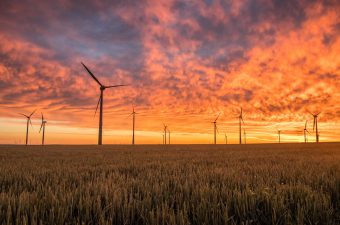Britain’s long heatwave threw the country’s green energy revolution into reverse and pushed up carbon emissions this summer, leading experts to stress the need for a diverse energy mix.

The summer of 2017 was lauded as the “greenest ever” for electricity generation, thanks to a growing number of windfarms and solar installations edging out coal and gas power stations.
But this year has seen a comparatively dirty summer for power generation, due to the weather’s impact on renewables.
The Met Office said the high pressure that caused much of the country to bask under sunny skies had suppressed windy conditions.
The weather proved a boon for staycations, garden centres and solar panel owners, but windfarms suffered. They usually provide four times as much power as solar each year.
The wind drought meant that at times turbine blades sat idle for days.
Windfarm capacity is up by more than 10% since a year ago, but the share of electricity they supplied dropped from 12.9% last year to 10.4% this summer, figures from National Grid show.
Although record-breaking solar output helped fill some of the gap and nuclear plants provided a bedrock of supply, gas power stations were fired up to meet demand.
The key measure of how green the power grid is – carbon intensity, measured in grammes of CO2 per kilowatt hour – was up by 8% on average over the past three months.
Duncan Burt, director of operations at National Grid, said: “We have seen a slight decrease in wind over the summer linked to the unusually warm weather, which demonstrates why it is important for us to have a diverse energy mix to ensure we can continue to manage supply and demand.”
He welcomed the growth in wind and solar over the past year, and said both were playing an increasingly important role in the energy system.
While this summer showed an uptick in carbon emissions, it is the second greenest ever.
And looking beyond the summer, carbon intensity for the year fell to a record low in the first eight months.
National Grid said the carbon intensity of electricity generation was down 3% to 252g CO2 per kWh between January and August, compared with the same period last year.
Windy conditions and new windfarms boosted wind energy during the winter, and coal use has fallen to new lows despite a brief resurgence during the “beast from the east”.
In June, the UK went 12 days without coal, which supplied less than 1% of electricity that month.
RenewableUK, the wind power industry body, said wind had “become a mainstream power source”.
A spokesperson for the Department for Business, Energy and Industrial Strategy said: “We’re investing up to £2.5bn in low-carbon innovation and are already seeing the results.”
Analysts have told renewable energy investors not to be alarmed about the lack of wind this summer.
After examining 17 years of monthly wind speeds in the UK, Bernstein bank concluded: “We do not find any evidence of a structural trend in wind speed over time.”
Experts also said that the way solar highs coincided with wind lows showed that both technologies were needed in the switch to green energy. Wind power generation is well ahead of solar in Europe.
Pascal Storck, director of renewable energy at environmental measurement firm Vaisala, said: “Often wind and solar technologies are played against each other, but the reality is that a diverse portfolio … will be the solution to long-term variability of this nature.”
Source: Guardian



